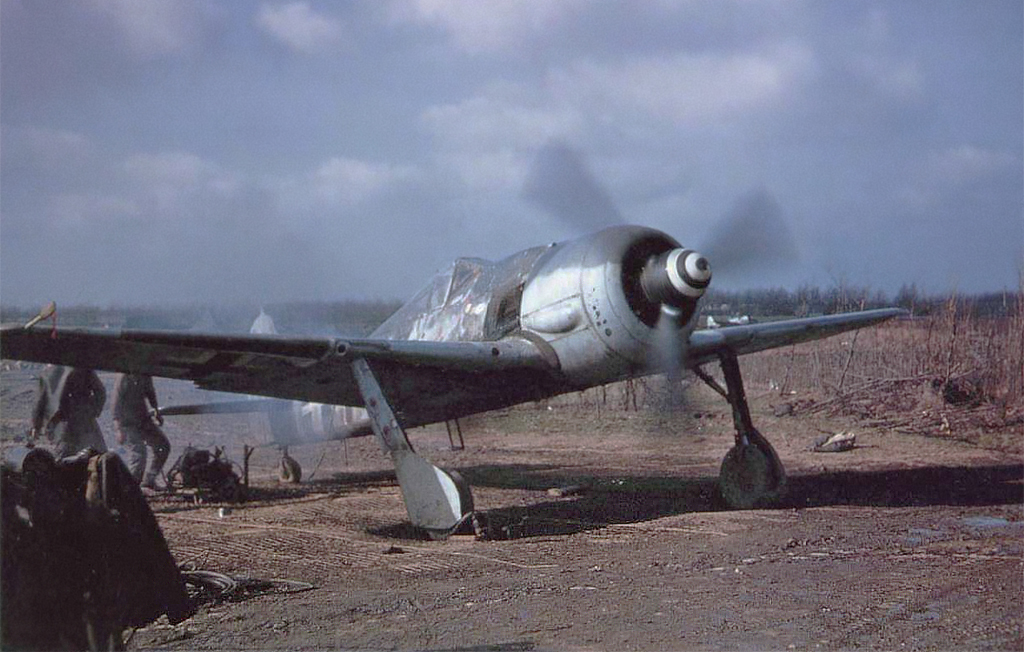In September 1941, the Fw 190 entered combat over northwest France and quickly established its dominance over the Mark V Spitfire, Britain’s greatest fighter at the time
One of Germany’s top fighter aircraft during World War II, the Focke-Wulf Fw 190, flew for the first time on June 1, 1939. It first saw action in September 1941 over northwest France and quickly established its dominance over the Mark V Spitfire, Britain’s greatest fighter at the time.
‘The Fw 190 was a much more modern aircraft than the Bf-109, and had superior agility at low level than the Bf-109 E and F models,’ Arthur Major an aviation expert explains on Quora. ‘The fact it was powered by an air-cooled radial engine also made it more resistant to battle damage than contemporary fighters powered by liquid-cooled engines (this is the same reasoning that the US Navy used in selecting their aircraft).’
In addition to being superior to the Spitfire Mk V at the time of its release, the Fw 190 was also highly-liked by Luftwaffe pilots for its sturdiness and capable ground handling as well as its performance (the wide track undercarriage contributed to this).
Major goes on:
‘As to the rest of the design philosophy, Kurt Tank wanted something more than an aircraft built only for speed. Tank outlined the reasoning:
‘The Messerschmitt 109 and the British Spitfire, the two fastest fighters in the world at the time we began work on the Fw 190, could both be summed up as a very large engine on the front of the smallest possible airframe; in each case, armament had been added almost as an afterthought. These designs, both of which admittedly proved successful, could be likened to racehorses: given the right amount of pampering and easy course, they could outrun anything. But the moment the going became tough they were liable to falter. During World War I, I served in the cavalry and in the infantry. I had seen the harsh conditions under which military equipment had to work in wartime. I felt sure that a quite different breed of fighter would also have a place in any future conflict: one that could operate from ill-prepared front-line airfields; one that could be flown and maintained by men who had received only short training; and one that could absorb a reasonable amount of battle damage and still get back. This was the background thinking behind the Focke-Wulf 190; it was not to be a racehorse but a Dienstpferd, a cavalry horse.
‘Kurt Tank’s design philosophy was well warranted, and the Fw-190 turned out to be one of the best fighters in the war, serving continuously throughout and being adapted for a multitude of missions, including fighter, fighter/bomber, night fighter and as the basis for multiple experimental weapons, including rockets, guided missiles and even 30mm recoilless cannon arranged to fire upwards when triggered by the shadow of an American bomber overhead.
‘The aircraft also underwent continuing improvements, including upgrades from machine guns to automatic cannons, improved engines, and eventually replacing the radial engine with the Junkers Jumo engine (Fw 190D) and massive aerodynamic improvements to create the Ta 152, which had the potential to become one of the “ultimate” piston engine fighters, although too little, too late.
‘With regard to 1941, the RAF was indeed concerned, as the Fw 190 was wresting air superiority from the RAF over the English Channel and impeding the ability to “lean forward” into occupied Europe.’

Major compares the Fw 190A and Spitfire V:
‘The British were keen to test captured Fw 190As during the war. The performance of the German fighter series had caused concern to RAF Fighter Command. Against the Spitfire V, the Fw 190 was found to be better in all respects with the exception of turning radius. At 2,000 ft, the Fw 190 was 25 to 30 mph faster; at 3,000 ft it was 30 to 35 mph faster. Its lowest speed advantage was 20 mph faster at 15,000 ft. At all altitudes, it remained the faster fighter. The Fw 190 was also faster in the climb. If a Fw 190 was engaged by a Spitfire V, it could use its superior roll rate to enter a dive in the opposite direction. Its dive speed would enable it to clear the Spitfire. In defensive mode, the Spitfire could evade an attack if caught at low speed only by using its advantage in turning circles. If traveling at maximum speed when engaged, the Spitfire could gain speed in the dive, forcing a longer chase, and drawing the Fw 190 further away from its landing ground.
‘Air Marshal Sholto Douglas expressed concerns that the Merlin-engine Spitfires were coming to the end of their developmental life, whereas the Fw 190 was only just beginning its career. At the time, he feared the enemy held the technological edge. Douglas determined that the Fw 190 was superior to the Spitfire V and also concluded that the Spitfire IX was also inferior in the climb and acceleration owing to negative G carburation. Douglas’ fears would prove overly pessimistic. The Spitfire IX would prove a clear match for the Fw 190A and the Griffon-engined Spitfire XIV would hold the edge on the type. In 1942 several tests were conducted by RAF pilots at the Royal Aircraft Establishment.’
Major comes to the following conclusion:
‘So initially, the Fw-190 was a superior aircraft to the RAF’s fighter fleet, and concern was well warranted until the Spitfire was improved to meet the new threat. Like everything else, there was a constant dance between the Allies and Axis as each side strove to improve their capabilities and abilities. Focke Wulf was able to surprise the RAF in 1941, and had a good, solid platform to build upon for the rest of the war.’

Photo by U.S. Air Force

